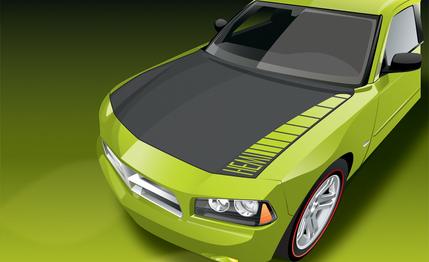
 First Drive Review
First Drive Review


In medieval times, a charger was a horse trained and equipped to carry guys into battle. Although not particularly fleet, they were big and powerful—useful attributes for lugging guys wearing iron hats, steel suits, chain-mail shirts, and leather underwear.
Fast forward about 1000 years. It's the summer of 1965, and the descendants of the medieval chargers have become the Budweiser Clydesdales. Meanwhile, several guys are sitting around an office in Highland Park, Michigan, brainstorming names for a hotted-up version of the Dodge Coronet. The age of the pony car is already at full gallop, thanks to the mid-'64 arrival of the Ford Mustang, so something horsy seems apropos: Charger. Romantic war-horse imagery backed by serious brute force in the form of Mopar's storied Hemi V-8.
Actually, the word Charger appeared in the Chrysler lexicon even before the Mustang trotted onto the scene. A Charger II concept car debuted at the '65 Chicago show, and Chrysler sold a "Hemi-Charger" package in '64 and '65. The package was designed primarily for drag racing and did not come with a warranty for street use. Yeah, right. Before you could say Woodward Avenue, Hemi hot rods were hammering around on public roads, and it wasn't long before Chrysler's marketing people decided to capitalize on a good thing.
The '66 Charger superimposed onto the Coronet chassis a two-door fastback with hidden headlights and full-width taillamps. It bore a strange resemblance to the unlovely AMC Marlin. And yeah, you could get that thing with a Hemi. Chrysler finally made the 426-cubic-inch Hemi available as a regular production option, one of three Charger V-8 engine choices. It was rated for 425 horsepower and 490 pound-feet of torque. Rating methods were different (SAE gross versus today's SAE net), but the 426 Hemi was stout enough to hustle a 4035-pound 1968 Charger to 60 mph in 4.8 seconds, as we discovered in a November 1967 test.
Nevertheless, most of the 37,344 Chargers produced for 1966 had one of the lesser eights—the 230-hp, 318-cubic-inch standard engine or the 265-hp, 361-cubic-inch upgrade option. Less than two percent of those '66 Chargers—just 468—had Hemis under their hoods.
Fast forward to 2004. The Chrysler Corporation has become DaimlerChrysler, the Hemi V-8 has been resurrected in a new and modern form, and Dodge is set to revive the Charger name when it unveils a new full-size, rear-drive sedan at the Detroit auto show in January.
As we go to press, this much has been confirmed by the company. What follows is informed speculation based on insider hints, heavily camouflaged spy photos, and various tidbits we've extracted from key players in the development project.
The Name
Chrysler Group design V-P Trevor Creed says the company "planned to do the Charger all along," but that's not entirely accurate. The car may have been a certainty, but the name was an open issue. Charger is a word that's loaded with powerful symbolism, and it still has plenty of proprietary identity with the Dodge division, but its cachet isn't quite as compelling as it once was.
This is attributable to certain abuses the name has suffered over the years. When emissions regs and the Arab oil embargo of 1973 put an end to Detroit's carefree big-inch V-8 heyday, Dodge began sticking Charger badges on rides that were, shall we say, not so noteworthy. The Hemi was gone by '72, and the Charger morphed into a big, soft luxury coupe before disappearing at the end of the '78 model year.